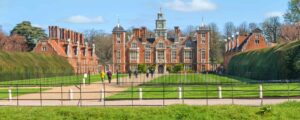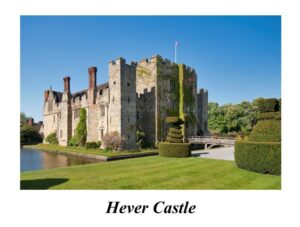Anne Boleyn is a very busy ghost. They claim that her ghost haunts several English castles. We all know Anne Boleyn was beheaded on the orders of her husband, Henry VIII. They say he was frustrated that she didn’t bear him a son and heir, and anyway he had found another, hopefully fertile, woman. It appears that Anne Boleyn decided to get her revenge, by haunting the King, as a ghost forever! Why do I say this, because there are reports of seeing her ghost, even today, nearly 700 years later.
Blickling Hall
 This is where she returns each year on 19th May, yes, you guessed it, that was the day she was beheaded. Some historians think that this is where she was born, they say it is the main reason for her returning every year. As night falls, a coach comes up the path to the house, but this coach is different. The coach is drawn by a headless horseman, with Anne Boleyn, holding her head on her lap. Isn’t that weird? Then, as it reaches the front door of Blickling Hall, it vanishes. Local folk tell the story that on her execution day, four headless horses were seen dragging the body of a headless man across the fields. Can you ever believe such local stories that have been passed down from fathers to sons for generations? I don’t think we will ever know.
This is where she returns each year on 19th May, yes, you guessed it, that was the day she was beheaded. Some historians think that this is where she was born, they say it is the main reason for her returning every year. As night falls, a coach comes up the path to the house, but this coach is different. The coach is drawn by a headless horseman, with Anne Boleyn, holding her head on her lap. Isn’t that weird? Then, as it reaches the front door of Blickling Hall, it vanishes. Local folk tell the story that on her execution day, four headless horses were seen dragging the body of a headless man across the fields. Can you ever believe such local stories that have been passed down from fathers to sons for generations? I don’t think we will ever know.
Other ghosts at Blickling Hall
It seems to be a very haunted hall, for example:
Sir Thomas Boleyn
Anne Boleyn’s father, Sir Thomas Boleyn, is said to haunt the building, because he took no action to prevent his two children being executed.
The other child was her brother, George Boleyn, Viscount Rochford, who was accused of incest with his sister during her trial for high treason. The result was that both were executed!
It appears that each year Sir Thomas’s ghost appears to attempt to cross 12 bridges before the cockcrows. His frantic route takes him from Blickling to Aylsham, Burgh, Buxton, Coltishall, Meyton, Oxnead and Wroxham. Is it another local folk tale?
The spirit of ‘Falstaff’
They also say that at the hall you can meet the ghost of Sir John Fastofe, he is said to be the inspiration for Shakespeare’s Falstaff.
Sir Henry Hobart’s dying groans
He was an MP, who lost his seat in 1698, which ended in a duel with Sir Oliver Le Neve who accused him of cowardice. Sir Hobart was a well-known swordsman, while Sir Oliver was more of a drinker, therefore, it was a forgone conclusion that Sir Hobart would win.
However, initially Hobart managed to wound Neve in the arm. Then he got his sword tangled in Neve’s clothing. Neve took advantage, while Hobart was busy disentangling himself, to drive his sword into Hobart and killed him.
They say you can still hear his dying groans coming from the West Turret Bedroom on the anniversary of his death.
Blickling Hall is a spooky place!
Hever Castle
 This is where the most prolific sightings have occurred. Hever Castle, which was her childhood home and where most people believe she was born. However, as you can see, no one is really, really sure. This is where she normally appears on Christmas Eve. Those people who have seen her say that:
This is where the most prolific sightings have occurred. Hever Castle, which was her childhood home and where most people believe she was born. However, as you can see, no one is really, really sure. This is where she normally appears on Christmas Eve. Those people who have seen her say that:
- Just as at Blickling Hall, she arrives in a horse-drawn carriage up the long pathway leading to the castle, but the horses are also headless!
- This time when she descends from her carriage in front of the castle steps, she is carrying her head in her hands!
- She then wanders around Hever Castle, through the gardens, the corridors, etc. until the morning, when she mysteriously disappears.
This means there are a lot of visitors at Hever Castle on Christmas Eve, all hoping that they catch a glimpse of the headless Queen!
The Tower of London
I told you before that she was an active ghost, as well at the two Castles, Anne’s ghost has also been seen:
- Walking over a bridge leading to the Tower of London (not certain which bridge), but she is seen, again, holding her head.
- She has even been seen spotted inside the Tower of London, wandering the corridors, and even in the chapel where she is buried.
That she still haunts the Tower of London isn’t surprising as it is considered the most haunted building in England!
Anywhere else?
Yep, she is even said to haunt Windsor Castle. Here she has been spotted running through corridors screaming, only this time her head is in the right place!

Our sister site Educational Musicals has published a musical Henry – The Break with Rome which tells you the story of the Break with Rome this led to Henry’s short marriage with Anne Boleyn.
To read two pages of script and hear two of the twelveoriginal songs that take the story along, simply click on Henry – The Break with Rome.
Isn’t History fun!
10 questions to discuss:
- Beyond Blickling Hall and Hever Castle, are there any other places with consistent reports of Anne Boleyn’s ghost?
- How do historians and skeptics explain the numerous ghost stories surrounding Anne Boleyn? Are there any psychological or social factors at play?
- What role do these ghost stories play in keeping the memory of Anne Boleyn alive? Do they have any historical value beyond entertainment?
- What potential harm or exploitation could result from sensationalizing historical figures like Anne Boleyn through ghost stories?
- How could we approach these stories with a more critical and nuanced lens, acknowledging both their entertainment value and their historical context?
- Is there any evidence to suggest that the locations mentioned in the blog, like Blickling Hall, actively promote these ghost stories for tourism purposes?
- How do the ghost stories about Anne Boleyn compare to those of other famous historical figures? Are there any common themes or patterns?
- Can the popularity of these ghost stories tell us anything about societal fascination with death, punishment, and powerful women in history?
- Beyond focusing on Anne Boleyn’s tragic end, do these stories explore other aspects of her life and legacy?
- Ultimately, what do you think the lasting impact of these ghost stories will be on how we remember and understand Anne Boleyn as a historical figure?
The aim of these questions is to encourage critical thinking and move beyond simply accepting the ghost stories as factual. They explore the historical context, potential motivations behind the stories, and their impact on our understanding of Anne Boleyn’s life and legacy.
For more information:
http://www.ghost-story.co.uk/index.php/ghosts/341-the-ghost-of-queen-anne-boleyn
https://www.hauntedrooms.co.uk/anne-boleyn-ghost-sightings-pictures
© Tony Dalton

